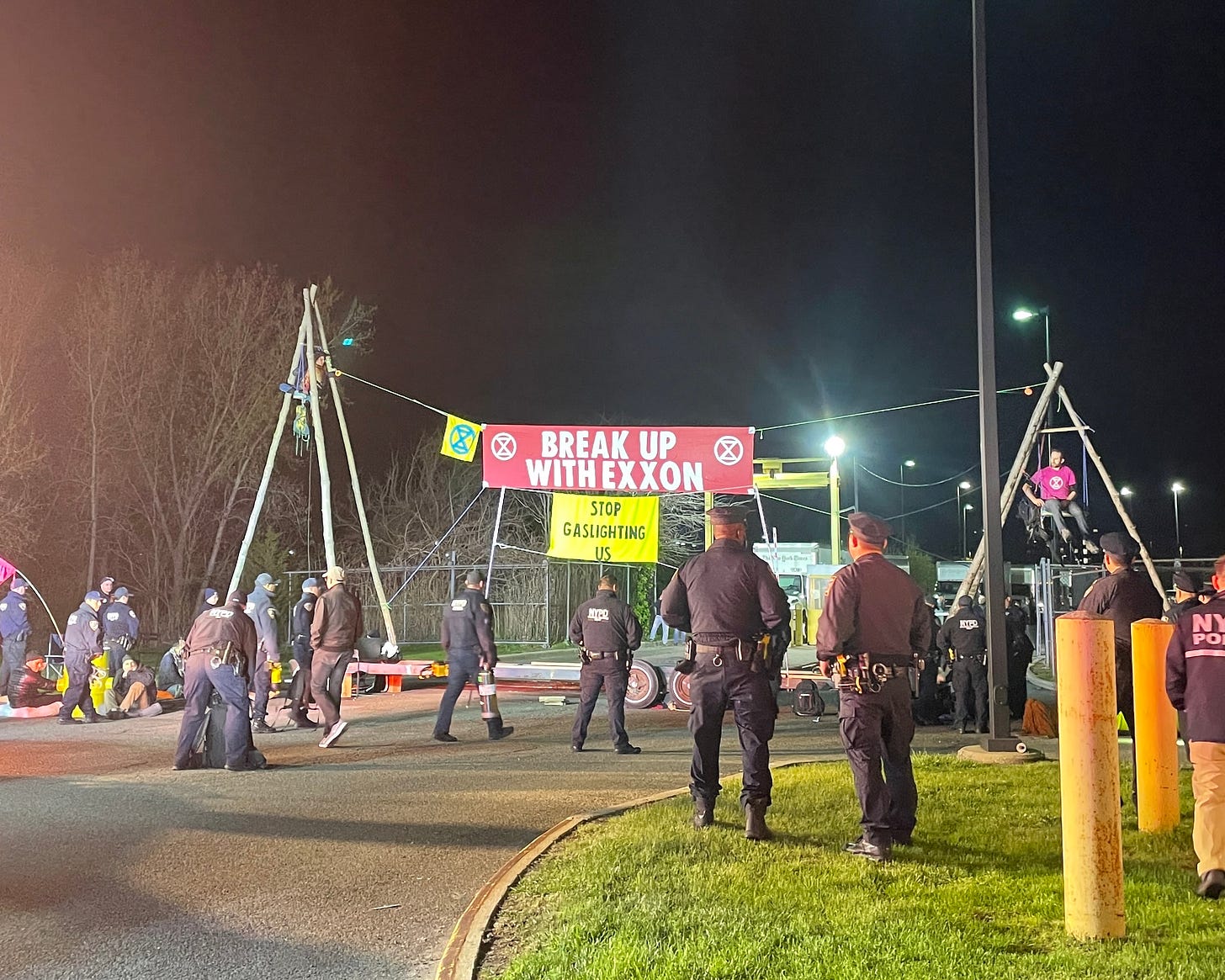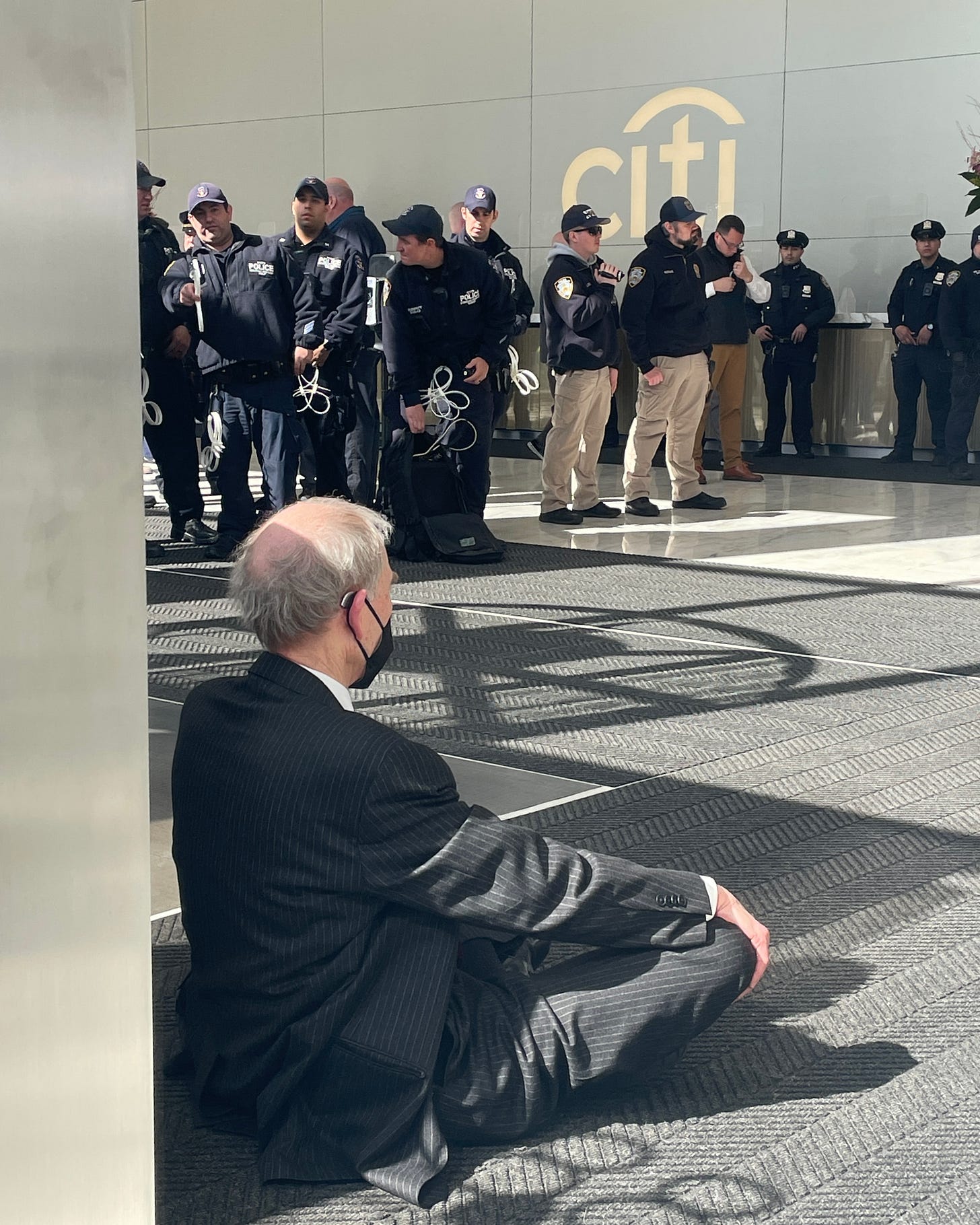Would You Get Arrested for Protesting Against Climate Inaction?
“This is what being sane looks like in an insane world.”
Notes from my latest for New York Magazine: After Two Years, Extinction Rebellion Returns.

When Greg Schwedock knows he’s going to get arrested, he likes to hide packets of mayonnaise in his clothing. It’s a trick that the 33-year-old climate activist actually picked up inside jail after one of his first arrests in January 2019, during which, by some prison-miracle, his lunch came with a packet of mayo—an elixir to his otherwise desperately barren cheddar cheese sandwich. The contraband doesn’t always make it inside. Sometimes he gets caught, and once, a packet exploded in his friends’ pants. But on a good day, if the police pat you down, said Schwedock, “It might just feel like flesh.”
As a full-time climate activist who’s been arrested 17 times now, arrest for Schwedock is just like another day at work. Schwedock is one of the many activists I interviewed for my latest story in New York Magazine, in which I profiled Extinction Rebellion (a.k.a. XR), the international climate movement that calls for mass nonviolent civil disobedience to provoke climate action. After a pandemic lull, the group returned in full force in New York this week for what they call their “Spring Rebellion,” unleashing protests around the city. On Wednesday morning, XR occupied the lobby of Citibank, one of the largest financiers of fossil fuels in the world. Just after midnight on Friday, XR blockaded the printing plant of The New York Times, The Wall Street Journal, and The New York Post for not covering the climate crisis enough and running fossil fuel ads. After 11 days, 78 arrests, and 17 summonses, the demonstrations have finally come to a close. But more will come. Because in our time of code-red climate emergency, the XR philosophy goes, inept government and industry must be met with mass disruption.
“The science is simple: we are so fucked,” said Schwedock. “We have to do everything humanly possible.”

As the NY Mag piece explores in full, arrest is not XR’s goal, they say, but rather a tactic—a risk that comes with bolder acts of disruption. As a privileged white guy, Schwedock feels comfortable taking high risk roles as often as he can. To be sure, arrest is not for everyone, and there are many other ways to participate in XR that don’t involve zip ties, from outreach to art to helping activists get out of jail. The resounding outlook is: do whatever is best for you, but if you do have the privilege—be that in the form of time, race, flexibility at work—and you’re willing, you should consider it. Because as governments and corporations continue to exacerbate the dangers laid out by the IPCC, the only way change will come, XR argues, is through mass nonviolent resistance.
I’ve seen firsthand the impacts of some of the most extreme climate change: fires, droughts, thawing permafrost. But never has its reality sunk in as deeply as it has after reporting on XR for the last month. In late March, I watched about two dozen activists blockade Third Avenue during rush hour and stand against three lanes of blaring trucks in 28 degree-weather to call on the state to pass a ban on natural gas. In the run-up to the protests this week, about 200 people attended half-day action training sessions to learn how to partake in civil disobedience and arrest. Henry, an activist in the story, even risked their job to get arrested. On Friday at the printing plant, 32 activists hooked themselves up to a combination of cement-filled barrels, steel pipes, tripods, and a boat for hours. It’s a level of sacrifice that I’ve never seen people make for climate change. Meanwhile, life goes on as usual. It’s almost as if New York is stuck in early March 2020, when everyone was fully aware that a deadly virus was circulating the globe, yet still hitting the bar with friends, pretending like nothing was going to happen.
Of course, there is the question of just how effective protest and arrest actually are in prompting change. Ultimately, the forces arrayed against climate action — Big Oil, political gridlock, entrenched denialism, climate despair, our entire way of life — are so powerful that it may take something far more radical than civil disobedience to create radical change. Swedish climate scholar and activist Andreas Malm makes the argument in his new-ish book, How to Blow Up a Pipeline, (which is not an instruction manual, as the provocative title would suggest), that it might take activists abandoning strategic nonviolence and taking up sabotage of fossil fuel infrastructure. In an even darker take, Dr. Dana R. Fisher, an expert on environmental activism and social movements at the University of Maryland, believes radical change will take “a huge shock to our system,” said Fisher, who is writing a book on the subject. That will likely be a climate one. “Unfortunately what will end up happening is there will be lots of people who may not make it to the other side,” namely the poor who can’t afford to save themselves from rising sea levels, drought, and famine. “That's the level of shock to the system we’ll need before social change is really possible.”
It’s grim. Extremely grim. So, as ridiculous as chaining yourself to a bank with mayonnaise in your pockets may seem, ultimately, protest is all we have. Said Schwedock: “This is what being sane looks like in an insane world.”


